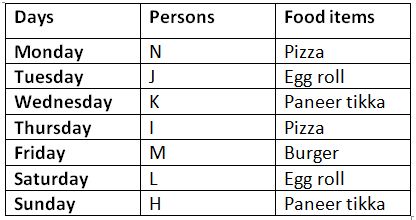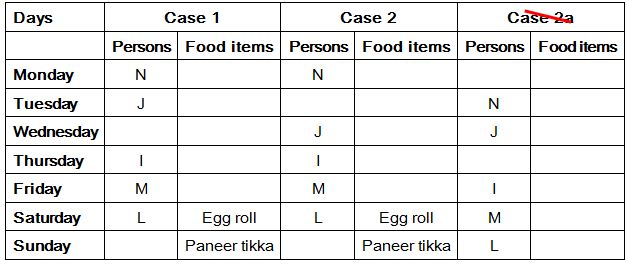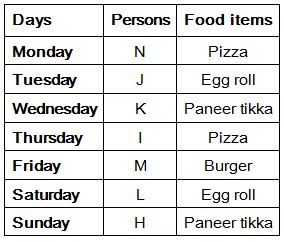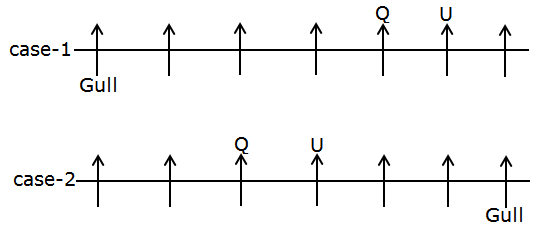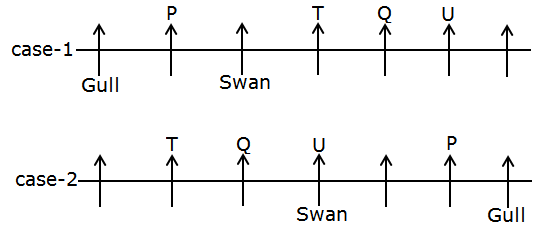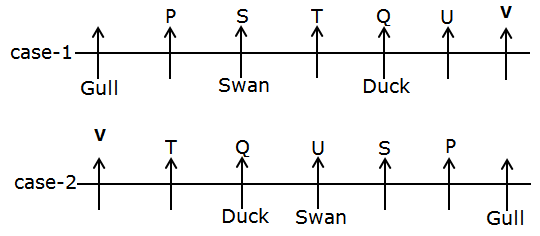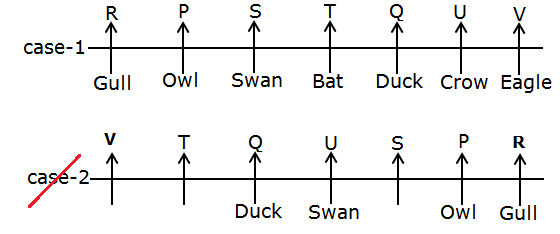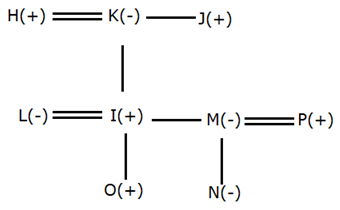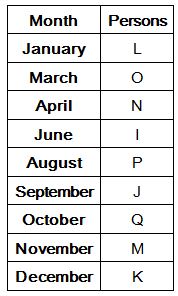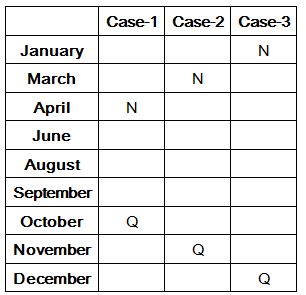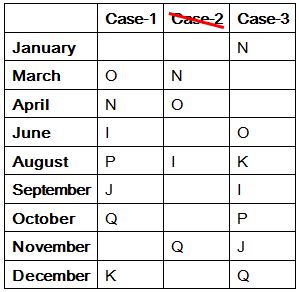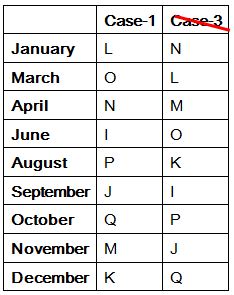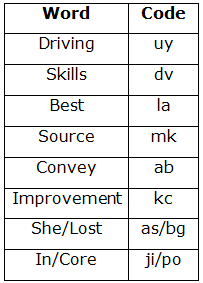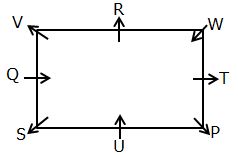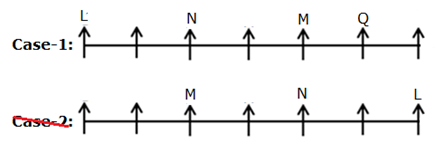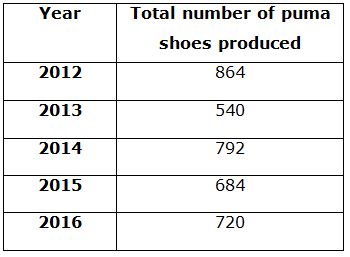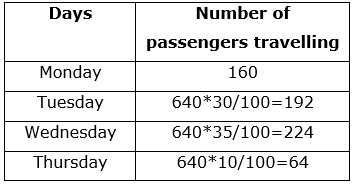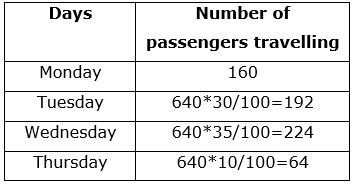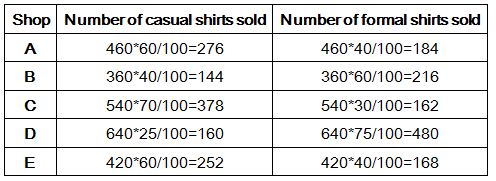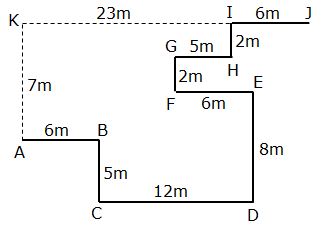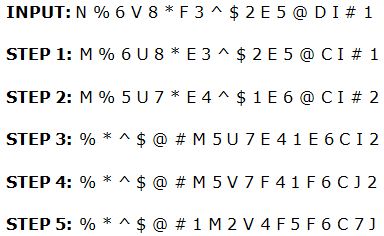IDBI Executive Mock Test - 3 - Bank Exams MCQ
30 Questions MCQ Test IDBI Executive Mock Test Series 2024 - IDBI Executive Mock Test - 3
Study the following information carefully and answer the questions given below:
Seven persons are going to watch the movie on seven different days starting from Monday to Sunday of the same week. They ordered different food items i.e., Paneer tikka, pizza, Egg roll, Burger. Not more than two persons ordered the same food items. J goes before Thursday and doesn’t order Burger. N goes before J. Two persons go between N and I who ordered the same item as N. L ordered Egg roll but goes before the one who ordered Paneer tikka. M goes to the movie immediately before L. K ordered Paneer tikka and goes before H but after J. M doesn’t order Egg roll and pizza. N and I who ordered the same item as N.
Q. Who among the following person orders Pizza?
Seven persons are going to watch the movie on seven different days starting from Monday to Sunday of the same week. They ordered different food items i.e., Paneer tikka, pizza, Egg roll, Burger. Not more than two persons ordered the same food items. J goes before Thursday and doesn’t order Burger. N goes before J. Two persons go between N and I who ordered the same item as N. L ordered Egg roll but goes before the one who ordered Paneer tikka. M goes to the movie immediately before L. K ordered Paneer tikka and goes before H but after J. M doesn’t order Egg roll and pizza. N and I who ordered the same item as N.
Study the following information carefully and answer the questions given below:
Seven persons are going to watch the movie on seven different days starting from Monday to Sunday of the same week. They ordered different food items i.e., Paneer tikka, pizza, Egg roll, Burger. Not more than two persons ordered the same food items. J goes before Thursday and doesn’t order Burger. N goes before J. Two persons go between N and I who ordered the same item as N. L ordered Egg roll but goes before the one who ordered Paneer tikka. M goes to the movie immediately before L. K ordered Paneer tikka and goes before H but after J. M doesn’t order Egg roll and pizza. N and I who ordered the same item as N.
Q. How many persons go to watch a movie between N and H?
Seven persons are going to watch the movie on seven different days starting from Monday to Sunday of the same week. They ordered different food items i.e., Paneer tikka, pizza, Egg roll, Burger. Not more than two persons ordered the same food items. J goes before Thursday and doesn’t order Burger. N goes before J. Two persons go between N and I who ordered the same item as N. L ordered Egg roll but goes before the one who ordered Paneer tikka. M goes to the movie immediately before L. K ordered Paneer tikka and goes before H but after J. M doesn’t order Egg roll and pizza. N and I who ordered the same item as N.
| 1 Crore+ students have signed up on EduRev. Have you? Download the App |
Study the following information carefully and answer the questions given below:
Seven persons are going to watch the movie on seven different days starting from Monday to Sunday of the same week. They ordered different food items i.e., Paneer tikka, pizza, Egg roll, Burger. Not more than two persons ordered the same food items. J goes before Thursday and doesn’t order Burger. N goes before J. Two persons go between N and I who ordered the same item as N. L ordered Egg roll but goes before the one who ordered Paneer tikka. M goes to the movie immediately before L. K ordered Paneer tikka and goes before H but after J. M doesn’t order Egg roll and pizza. N and I who ordered the same item as N.
Q. Which among the following statement is not true?
Seven persons are going to watch the movie on seven different days starting from Monday to Sunday of the same week. They ordered different food items i.e., Paneer tikka, pizza, Egg roll, Burger. Not more than two persons ordered the same food items. J goes before Thursday and doesn’t order Burger. N goes before J. Two persons go between N and I who ordered the same item as N. L ordered Egg roll but goes before the one who ordered Paneer tikka. M goes to the movie immediately before L. K ordered Paneer tikka and goes before H but after J. M doesn’t order Egg roll and pizza. N and I who ordered the same item as N.
In the given question, the relationship between different elements is shown in the statements followed by three conclusions. Find the conclusion which is definitely true.
Q. Statements:
D > Q = U ≥ P < A = I; P ≥ V ≥ K > C ; V < J = T
Conclusions:
I. T > C
II. K < Q
III. I > V
Study the following information carefully and answer the questions given below.
In a Circus, seven cages - P, Q, R, S, T, U and V are placed in a straight line facing towards north, but not necessarily in the same order. Each cage has different birds - Duck, Eagle, Gull, Swan, Bat, Crow and Owl.
U is placed immediate right of Q but none of them is placed at the ends of the row. Only three cages are placed between Q and the cage which has Gull, which is placed at one of the ends. P is placed adjacent to the cage which has Gull. The cage which has Swan is placed exactly between P and T. As many cages placed to the right of S as to the left of the cage which has Duck. Neither S nor V has Gull. Only two cages are placed between the cages which have Duck and Owl. The cage which has Bat is placed two places away from the cage which has owl. U doesn’t have Eagle.
Q. Which of the following cage has crow?
Study the following information carefully and answer the questions given below.
In a Circus, seven cages - P, Q, R, S, T, U and V are placed in a straight line facing towards north, but not necessarily in the same order. Each cage has different birds - Duck, Eagle, Gull, Swan, Bat, Crow and Owl.
U is placed immediate right of Q but none of them is placed at the ends of the row. Only three cages are placed between Q and the cage which has Gull, which is placed at one of the ends. P is placed adjacent to the cage which has Gull. The cage which has Swan is placed exactly between P and T. As many cages placed to the right of S as to the left of the cage which has Duck. Neither S nor V has Gull. Only two cages are placed between the cages which have Duck and Owl. The cage which has Bat is placed two places away from the cage which has owl. U doesn’t have Eagle.
Q. If cage V is related to Duck and cage R is related to Swan in a certain way, then cage P is related to which of the following bird?
Study the following information carefully and answer the questions given below.
In a Circus, seven cages - P, Q, R, S, T, U and V are placed in a straight line facing towards north, but not necessarily in the same order. Each cage has different birds - Duck, Eagle, Gull, Swan, Bat, Crow and Owl.
U is placed immediate right of Q but none of them is placed at the ends of the row. Only three cages are placed between Q and the cage which has Gull, which is placed at one of the ends. P is placed adjacent to the cage which has Gull. The cage which has Swan is placed exactly between P and T. As many cages placed to the right of S as to the left of the cage which has Duck. Neither S nor V has Gull. Only two cages are placed between the cages which have Duck and Owl. The cage which has Bat is placed two places away from the cage which has owl. U doesn’t have Eagle.
Q. Which of the following statement is true with respect to the final arrangement?
Study the following information carefully and answer the questions given below.
There are nine members in a family has three married couples. J is the maternal uncle of M who is the sister-in-law of L. L has no siblings. N is the daughter of P who is the son-in-law of K. M is the aunt of O who is the grandson of H. I is the brother-in-law of P.H is the father-in-law of I’s wife. O and N belongs to the same generation.
Q. If V is the son-in-law of P, then how is N related to V?
Study the following information carefully and answer the below questions.
Nine persons- I, J, K, L, M, N, O, P and Q received their first-month pension in different months- January, March, April, June, August, September, October, November, and December of the same year.
N received the pension before June. As many persons received the pension before N as after Q. Only two persons received the pension between Q and I.O received two persons before I.P received the pension immediately before J. J did not receive the pension in the month which has 31 days. Only two persons received the pension between J and K.L received before M who did not receive the pension immediately before O.
Q. As many persons receivedthe pension before O as after ______.
Study the following information carefully and answer the below questions.
Nine persons- I, J, K, L, M, N, O, P and Q received their first-month pension in different months- January, March, April, June, August, September, October, November, and December of the same year.
N received the pension before June. As many persons received the pension before N as after Q. Only two persons received the pension between Q and I.O received two persons before I.P received the pension immediately before J. J did not receive the pension in the month which has 31 days. Only two persons received the pension between J and K.L received before M who did not receive the pension immediately before O.
Q. Which of the following statement(s) is/are true?
Study the following information carefully and answer the below questions.
Nine persons- I, J, K, L, M, N, O, P and Q received their first-month pension in different months- January, March, April, June, August, September, October, November, and December of the same year.
N received the pension before June. As many persons received the pension before N as after Q. Only two persons received the pension between Q and I.O received two persons before I.P received the pension immediately before J. J did not receive the pension in the month which has 31 days. Only two persons received the pension between J and K.L received before M who did not receive the pension immediately before O.
Q. Four of the following five are alike in a certain way as per the given arrangement and hence form a group. Find the one that doesn't belong to that group.
Study the following information carefully and answer the questions given below.
In a certain code language,
“Driving skills best source” is coded as “mk dv uy la”
“Source convey skills improvement” is coded as “kc mk ab dv”
“She lost best skills” is coded as “dv as la bg”
“Improvement in best core” is coded as “ji kc la po”
Q. If “She convey best message” is coded as “bg ab la vc”, then what is the code for the phrase “lost core knowledge” in the given code language?
Study the following information carefully and answer the questions given below.
In a certain code language,
“Driving skills best source” is coded as “mk dv uy la”
“Source convey skills improvement” is coded as “kc mk ab dv”
“She lost best skills” is coded as “dv as la bg”
“Improvement in best core” is coded as “ji kc la po”
Q. What is the code for the word “Convey” in the given coded language?
Study the following information carefully and answer the questions given below
Eight persons are sitting around a rectangular table, where some of them are facing towards the centre and some are facing away from the centre of the table. Four persons are sitting in the corners and the remaining persons are sitting in the middle of the sides of the table.
V, who neither sits on the sides of the table nor faces P, sits third to the left of U. Both V and U are facing opposite directions. Two persons sit between U and W. The immediate neighbours of W face the same direction. R sits immediate right of W. As many persons sit between R and S as between S and T, who sits opposite to Q who is not an immediate neighbour of W. Both P and R are facing the opposite direction of W. The immediate neighbours of S face the opposite direction of both S and T.
Q. If all the persons are made to sit in alphabetical order from the position of Q in an anti-clockwise direction, then how many of them remain in the same position?
Study the following information carefully and answer the questions given below
Eight persons are sitting around a rectangular table, where some of them are facing towards the centre and some are facing away from the centre of the table. Four persons are sitting in the corners and the remaining persons are sitting in the middle of the sides of the table.
V, who neither sits on the sides of the table nor faces P, sits third to the left of U. Both V and U are facing opposite directions. Two persons sit between U and W. The immediate neighbours of W face the same direction. R sits immediate right of W. As many persons sit between R and S as between S and T, who sits opposite to Q who is not an immediate neighbour of W. Both P and R are facing the opposite direction of W. The immediate neighbours of S face the opposite direction of both S and T.
Q. If all the persons are made to face the opposite direction from their actual direction, then who sits second to the right of the one who sits immediate left of W?
Each of the questions below consists of a question and two statements numbered I and II given below it. You have to decide whether the data provided in the statements are sufficient to answer the questions:
a) If the data in Statement I alone is sufficient to answer the question, while the data in statement II alone is not sufficient to answer the question.
b) If the data in Statement II alone is sufficient to answer the question, while the data in statement I alone is not sufficient to answer the question.
c) If the data either in Statement I alone or in Statement II alone is sufficient to answer the question.
d) If the data in both Statements I and II together are not sufficient to answer the question.
e) If the data in both Statements I and II together are necessary to answer the question.
Q. Seven friends L, M, N, O, P, Q and R are sitting in a row facing north but not necessarily in the same order. Who among the person sits fourth to the left of Q?
I. L sits at one of the extreme ends of the row. Only three persons sit between L and M. N sits two places away from M and doesn’t sit at any end. Q sits third to the right of N.
II. Q sits second from one of the ends of the row. Only two persons sit between Q and N. R sits immediate left of N.
Each of the questions below consists of a question and two statements numbered I and II given below it. You have to decide whether the data provided in the statements are sufficient to answer the questions:
a) If the data in Statement I alone is sufficient to answer the question, while the data in statement II alone is not sufficient to answer the question.
b) If the data in Statement II alone is sufficient to answer the question, while the data in statement I alone is not sufficient to answer the question.
c) If the data either in Statement I alone or in Statement II alone is sufficient to answer the question.
d) If the data in both Statements I and II together are not sufficient to answer the question.
e) If the data in both Statements I and II together are necessary to answer the question.
Q. What is the code for “Looks” in the coded language?
I. “Athlete related question asked” is coded as “sd fs yu er” and “Question for athlete person” is coded as “ab fs po sd”
II. “Athlete person looks strong” is coded as “sd hj po ks” and “Question looks very critical” is coded as “fs ks rd ja”
Read the following information carefully and answer the given questions.
The given below pie chart shows the percentage distribution of the total number of puma shoes produced in Factory A in five different years 2012, 2013, 2014, 2015 and 2016.
Total number of puma shoes produced in all years together = 3600
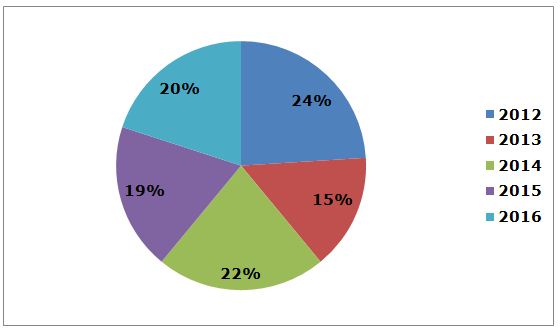
Q. Ratio of the number of black to white Puma shoes produced in 2014 and 2015 is 5:3 and 5:4 respectively. Find the total number of white Puma shoes produced in 2014 and 2015 together.
Read the following information carefully and answer the given questions.
The given below pie chart shows the percentage distribution of the total number of puma shoes produced in Factory A in five different years 2012, 2013, 2014, 2015 and 2016.
Total number of puma shoes produced in all years together = 3600

Q. If the ratio of the total number of Adidas to Puma shoes produced in 2016 is 13:12 and the total number of Adidas shoes produced in 2017 is 33.33% more than that of in 2016, then find the total number of Adidas shoes produced in 2017.
Study the following information carefully and answer the questions given below.
The given below bar graph shows the percentage breakup of the number of passengers travelling in Bus A of transport company XYZ in four different days of week ( Monday, Tuesday , Wednesday and Thursday).
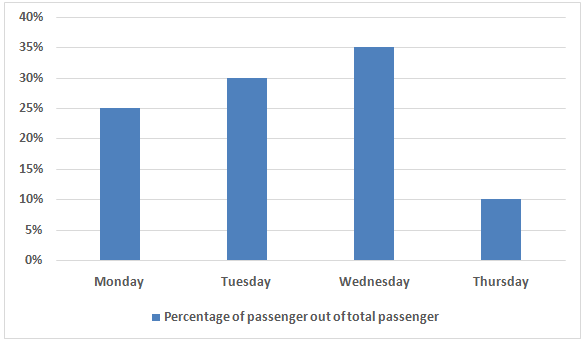
Note: Total number of passengers travelling in four days of a week is 640.
Q. On Friday, the number of passengers travelling in bus A is 25% more than the number of passengers travelling in bus A on Wednesday and the number of passengers travelling in bus B of the same company on Friday is 44 more than the number of passengers travelling in bus A on Friday. Find the average number of passengers travelling in bus A and bus B on Friday?
Study the following information carefully and answer the questions given below.
The given below bar graph shows the percentage breakup of the number of passengers travelling in Bus A of transport company XYZ in four different days of week ( Monday, Tuesday , Wednesday and Thursday).

Note: Total number of passengers travelling in four days of a week is 640.
Q. Number of passengers travelling in bus B of the same company on Tuesday is 25% less than the number of passengers travelling in bus A of company XYZ on Tuesday. Find the number of passengers travelling in Bus B of company XYZ on Tuesday.
Study the following information carefully and answer the questions given below.
The given below bar graph shows the percentage breakup of the number of passengers travelling in Bus A of transport company XYZ in four different days of week ( Monday, Tuesday , Wednesday and Thursday).

Note: Total number of passengers travelling in four days of a week is 640.
Q. On Saturday, the number of male passengers travelling in Bus A is half of the total number of passengers travelling on Monday and the number of female passengers travelling on same day is 25 more than the number of male passengers travelling. Find the ratio of number of male to female passengers travellingon Saturday?
Study the following information carefully and answer the questions given below.
The given line graph shows the total number of shirts [casual + formal] sold in five different shops [A, B, C, D and E] and also given the percentage of formal shirts sold out of total number of shirts sold in each shop.
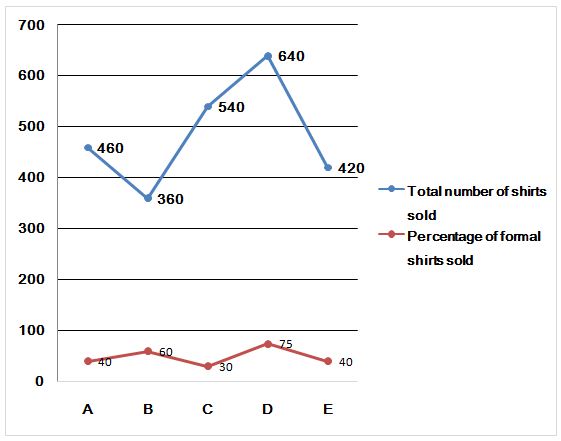
Q. Find the difference between the total number of casual shirts sold in shop A and B together and the total number of formal shirts sold in shop D and E together?
Study the following information carefully and answer the questions given below.
The given line graph shows the total number of shirts [casual + formal] sold in five different shops [A, B, C, D and E] and also given the percentage of formal shirts sold out of total number of shirts sold in each shop.

Q. Find the ratio between the average of the total number of formal shirts sold in all shops together and the average of the total number of casual shirts sold in all shops together?
If all the consonants of the word “MANUFACTURED” are changed to the previous letter and the vowels are changed to the next letter as per the alphabetical series and all the letters are arranged in the English alphabetical order from left to right then the positions of 1st and 12th letters and 2nd and 11th letter and so on are interchanged. Find the letter which is third from the right end after the rearrangement.
STATEMENT: According to the officials, paucity orphaned with organization has led to the pathetic condition of this brilliant architectural structure. An organization is considered orphaned when the organization Owner and all Project Collection Administrators are inactive in Azure Active Directory (Azure AD) or have left the company. This scenario causes the organization to have no administrator and no way of transferring administrator rights to another user.
Course of Action:
- A new architectural structure for the building should be designed.
- Grant should be given to improve the condition of the structure.
- The reason for the poor condition of the structure should be found out.
Study the following information carefully and answer the questions given below.
Ten pillars are in different positions in a hall. Pillar A is 6m to the west of pillar B, which is 5m to the north of pillar C. Pillar D is 12m to the east of pillar C and 8m to the south of pillar E, which is 6m to the east of pillar F. Pillar G is 2m to the north of pillar F and 5m to the west of pillar H. Pillar J is 6m to the east of pillar I, which is 2m to the north of pillar H.
Q. What is the shortest distance between pillars B and D?
Study the following information carefully and answer the questions given below.
Ten pillars are in different positions in a hall. Pillar A is 6m to the west of pillar B, which is 5m to the north of pillar C. Pillar D is 12m to the east of pillar C and 8m to the south of pillar E, which is 6m to the east of pillar F. Pillar G is 2m to the north of pillar F and 5m to the west of pillar H. Pillar J is 6m to the east of pillar I, which is 2m to the north of pillar H.
Q. If pillar K is 7m to the north of pillar A, then what will be the shortest distance between pillar J and K?
Study the following information carefully and answer the questions given below.
An alphanumeric symbol arrangement machine, when given an input, rearranges them by following a particular rule in each step. The following is an illustration of input and steps rearrangement.
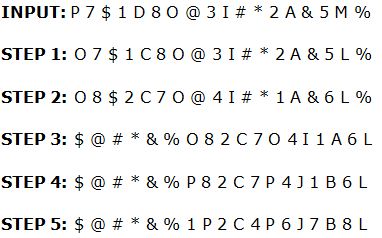
STEP 5 is the last and final step of the rearrangement. As per the rules followed in the above steps, find out the appropriate steps for the following input.
INPUT: N % 6 V 8 * F 3 ^ $ 2 E 5 @ D I # 1
Q. How many letters are there in the English alphabetical series between the elements seventh from both the left and the right ends in step 2 of the given input?
Study the following information carefully and answer the questions given below.
An alphanumeric symbol arrangement machine, when given an input, rearranges them by following a particular rule in each step. The following is an illustration of input and steps rearrangement.

STEP 5 is the last and final step of the rearrangement. As per the rules followed in the above steps, find out the appropriate steps for the following input.
INPUT: N % 6 V 8 * F 3 ^ $ 2 E 5 @ D I # 1
Q. How many vowels are there in the final step of the given input?


